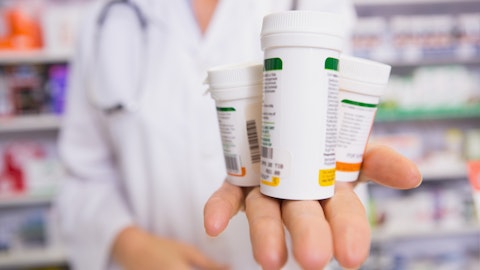Evoke Pharma, Inc. (NASDAQ:EVOK) Q4 2023 Earnings Call Transcript March 14, 2024
Evoke Pharma, Inc. misses on earnings expectations. Reported EPS is $-0.59 EPS, expectations were $-0.5. Evoke Pharma, Inc. isn’t one of the 30 most popular stocks among hedge funds at the end of the third quarter (see the details here).
Operator: Good afternoon, and welcome to the Evoke Pharma Fourth Quarter and Full-Year 2023 Earnings Conference Call. Currently, all callers have been placed in a listen-only mode. [Operator Instructions] Please be advised that today’s call is being recorded. I will now turn the call over to Daniel Kontoh-Boateng. Please go ahead, sir.
Daniel Kontoh-Boateng: Good afternoon, and thank you for participating in Evoke Pharma’s conference call and webcast today. With me today are Dave Gonyer, Evoke’s Chief Executive Officer; Chris Quesenberry, GIMOTI’s Chief Commercial Officer from Eversana; and Matt D’Onofrio, Evoke’s President and Chief Operating Officer. By now, you should have a copy of the press release we issued earlier. If not, it is available on the Investor Relations page of our website at evokepharma.com. We encourage everyone to read today’s press release as well as Evoke’s annual report on Form 10-K, which is now filed with the SEC. The company’s Form 10-K and earnings release are also available on Evoke’s website. Please note that certain information discussed on the call today is covered under the safe harbor provisions of the Private Securities Litigation Reform Act.
We caution listeners that, during this call, management will be making forward-looking statements. Actual results could differ materially from those stated or implied by these forward-looking statements due to risks and uncertainties associated with the company’s business. These forward-looking statements are qualified by the cautionary statements contained in Evoke’s press releases and SEC filings, including its annual report on Form 10-K and subsequent filings. This conference call contains time-sensitive information that is accurate only as of the date of this live broadcast. Evoke undertakes no obligation to revise or update any forward-looking statements to reflect events or circumstances after the date of this conference call and webcast.

A clinical researcher in a lab examining a new biopharmaceutical product.
With that, I would now like to turn the call over to David Gonyer. Dave?
David Gonyer: Thank you, Daniel, and thanks, everyone, for joining the call this afternoon. As was described in today’s press release, 2023 marks a milestone in Evoke’s journey, not just commercially, but also in fulfilling our core mission, which is ensuring GIMOTI is within reach for every patient who needs it. Let me tell you why this core mission is so important. It’s because it’s about the patient and their experiences that can and will fuel the progress to help us fuel the progress as an organization. A testament to our efforts comes from the countless positive stories we’ve been told from health care providers, patients and our own sales representatives who hear and tell us some amazing patient success stories on a daily basis.
See also 25 Poorest States in the US in 2024 and 20 Cities Where Home Prices Are Falling Most in the US.
Q&A Session
Follow Evoke Pharma Inc (NASDAQ:EVOK)
Follow Evoke Pharma Inc (NASDAQ:EVOK)
While gastroparesis impacts predominantly women, today, I’d like to share just a brief very inspiring story that was just shared to us this week, about a 30-year-old male who battled both type 1 diabetes and severe gastroparesis. This man who was in and out of the hospital just about every month because of his gastroparesis, shared with this health care provider that, since starting on GIMOTI, he hasn’t had a single hospital visit, not one. And to his admission, it’s been life-changing for him. It’s stories like these that will push payers and providers and advocates to fight for patients who suffer from this insidious disease so they can receive the best care possible. Now this is just one of many affirmations we have heard that continues to energize our commitment.
Now while we’re humbled to receive these stories of success, we also want to encourage providers to do more to diagnose and treat these patients with gastroparesis. But unfortunately, the norm for patients is to wait years before they’re diagnosed. And then often told there’s not much that can be done for them. When treatment is prescribed, all too often, payers are pushing the cost to the patient, or outright denying coverage. Payers can do better and patients get their better treatment. The compelling evidence for GIMOTI goes beyond anecdotes. The scientific groundwork, the publication of our Phase 3 clinical data and the peer-reviewed and plenary presentations of our real-world health resource utilization studies at leading gastroenterology congresses, demonstrating a reduction in emergency room and hospital visits, and the significant total health care cost savings compared to oral metoclopramide underscores the value of GIMOTI versus the current gold standard.
Our story is really simple and straightforward, and it’s shaping up to be very compelling as well. GIMOTI achieves rapid and direct absorption in the bloodstream. GIMOTI provides documented symptomatic relief as early as one week. And now GIMOTI shows improved outcomes versus oral metoclopramide. The drug delivery through the nose avoids the problem of the disease, which is an inability to predictively deliver pills into the small intestine to be absorbed. Importantly, many patients previously had oral metoclopramide in the HRU study or the health resource utilization study, who were switched to GIMOTI, likely because they were not doing well, experienced the same reduction in ER visits and hospitalizations while taking GIMOTI, confirming its place as a transformative medicine in gastroparesis treatment.
Now let me switch gears a bit and turn to some highlights for 2023. I’m happy to report that we doubled our net revenue for GIMOTI over the last year. The number of new prescriptions grew by a notable 86% and total prescriptions dispensed increased by 101% year-over-year, clearly demonstrating the growing demand for GIMOTI. We also augmented our prescriber base by 72% while amplifying the depth of their prescribing by 36%. Our commercial team’s relentless focus propelled our targeting and outreach to health care providers, driving our financial achievements above our expectations. At important gastroenterology gatherings such as Digestive Disease Week and the American College of Gastroenterology Conferences, our data was selected by the respective governing boards for plenary presentations at both meetings.
This is a testament to the strength and the importance of the health resource utilization study we perform, as data highlighted GIMOTI’s role in significantly reducing ER visits and hospitalizations, outperforming oral metoclopramide and delivering care at a reduced price. This evidence not only resonated with GI professionals but also underscores our commitment to patient care and economic efficiency for payers. Furthering our strategic initiatives, we transitioned our pharmacy services to ASPN. The strategic alignment with ASPN’s robust platform positions us to better meet our distribution needs, enhance patient access, and streamline our services. And Chris will elaborate a little bit more on this in a moment. Looking back on a year of dynamic growth, our strategic investments have paid dividends.
We’ve not only strengthened the belief in GIMOTI, but doubled the patient count on therapy. As we lean into 2024, we’re aiming high with a projected net revenue of approximately $14 million, nearly tripling our 2023 performance. And with that, let me turn it over to Chris to talk about our current commercialization activities and plans moving forward for this year.
Christopher Quesenberry: Thanks, Dave. To confirm the uptake and acceptance that Dave just spoke about and revalidate last year’s commercial strategy, we also took a look at providers consecutively prescribing GIMOTI after their initial script. This slide denotes that close to 30% of our cumulative prescribers, which totaled 1,748 physicians, have prescribed GIMOTI, 5, or more times. The riders that have written prescriptions continue to write more and more over time. From our standpoint, this is highly encouraging and a strong testament to the drug’s efficacy and prescriber and user-friendly profile. The unabated adding of new prescribers or so-called breadth of prescribing in 2023, while simultaneously continuing to grow the depth of prescribing, is difficult to do and is also an indication that there is still significant potential for growth for GIMOTI.
We have not reached any ceiling of use for GIMOTI. Quite the opposite is true. While not shown on the slide, our market share of metoclopramide — of the metoclopramide market showed similar gains throughout 2023. Encouragingly, as you look across important prescriber audiences, the share of GIMOTI compared to oral metoclopramide grew throughout 2023, and it’s progressively stronger as you move from all potential prescribers of GIMOTI to those that are not call plan target list, and further improves as you look specifically at call time targeted gastroenterologists. Importantly, our highest share for GIMOTI is with nurse practitioners and physician assistants, who provide a significant portion of the medical care for patients with gastroparesis as many gastroenterologists spend less time in clinic, deciding instead to perform procedures or scopes.
As mentioned, our objective is to nearly triple our performance in 2023 — or excuse me, in 2024. In 2023, we built a solid foundation and believe we have earned the right to challenge our provider and payer colleagues to offer GIMOTI to a broader base of patients within diabetic gastroparesis. Throughout 2024 and beyond, our focus remains steadfast, reinforce the belief in GIMOTI amongst providers. Importantly, we will make clear that oral metoclopramide did not have the same health care resource utilization in patient reduction that GIMOTI provided and underscore that the nasal route of administration matters. For appropriate patients, we will ask providers to switch to GIMOTI, thereby broadening and deepening prescribing. We have addressed improving the fill rate for GIMOTI and will continue this imperative throughout 2024.
We earned a significant amount of prescribing of GIMOTI in 2023 and much of it was unable to be filled because providers sent the prescription to a local retail pharmacy. We will use tools and partners to mitigate this and guide scripts to a pharmacy in our network to capture scripts appropriately. Lastly, we will increase our communication and education for tardive dyskinesia and leverage latent concerns to clarify risks and encourage appropriate benefit risk discussions. Here again, there is tremendous untapped potential to clarify appropriate use. We will be clear about who is inappropriate for GIMOTI and request those who are appropriate to be offered GIMOTI. Tactically, here’s how we plan to build on these initiatives. We will continue to promote and advocate for GIMOTI as the optimal choice for gastroparesis treatment due to its optimized nasal administration.
We will support this with our quantitative and qualitative health care utilization data. And currently, we are partnering with pharmacy organizations to leverage their systems and services to mitigate prescriptions that fall outside our distribution lines and never reach patients. Additionally, with ASPN Pharmacy joining our network, we will gain access to their extensive pharmacy distribution network, including specialty drug pharmacies, improving GIMOTI’s fill rates and ensuring our patients receive the treatment they need without delay. Through appropriate channels, we’ll also persist to demystify the risks associated with tardive dyskinesia or TD, through education and transparency. For background, tardive dyskinesia is the side effect of select medications more commonly seen with older antiseptic medication that causes involuntary movements to one’s face and body that can’t be controlled.
The recent ACG guidelines indicate the risk of this side effect due to exposure to metoclopramide is lower than previously thought. In fact, it’s likely less than 1%. And our only claims analysis presented at DDW in 2022 confirmed ACG’s conclusion. By presenting clear data, including the low incidence, and which at-risk patients to avoid, we are shifting the narrative from fear to informed prescribing and monitoring. We believe this will reset perceptions and encourage physicians to prescribe GIMOTI to appropriate patients with confidence backed by a comprehensive understanding of a safety profile. As we build demand and utilization of GIMOTI, we’ve taken deliberate strides to enhance the accessibility of GIMOTI by evolving our distribution and pharmacy capabilities.
Our journey began with EvokeAssist or Eversana Pharmacy, which allowed us to implement the system swiftly though it relied on manual processes and had longer fulfillment times. As we progress to VidaCare, we significantly upgraded our capabilities, integrating seamlessly with medical workflows, enabling electronic prescribing, facilitating automatic refills — excuse me, automated refills to expedite the filling process. Now with Asembia, we’ve taken our distribution to the next level. Building on our previous advancements, Asembia offers real-time patient communication via text, complete end-to-end automation, including prior authorizations, and transparent prescription status through accessible portals to physicians and patients. This not only streamlines the prescription process for health care providers, but also ensures the patients receive their medication promptly.
Most importantly, Asembia’s robust infrastructure and expansive pharmacy network position us to further scale our reach and positively impact patient outcomes. These strategic enhancements embody our commitment to optimizing the GIMOTI access and signify our unwavering dedication to patient care. Although we’ve only just initiated our partnership with Asembia, also known as ASPN Pharmacies, in November of 2023, it’s clear we’ve identified a critical lever for enhancing our fill rates. Through refined strategy and communication and process optimization within the ASPN platform, we’ve seen a tangible uptick in our conversion rates. Specifically, there’s been a 2% overall increase in the number of new prescriptions filled, even more impressive when we exclude and process prescriptions, and improvement jumps to 22%.
Moreover, we’re seeing a significant shift towards greater efficiency with a 6% increase in sales that are reimbursed without the need for our patient affordability programs, a testament to streamline process, an inherent value proposition on GIMOTI. Additionally, ASPN’s focus on rapid and transparent patient communication is yielding results. With ASPN, there’s been a 12% reduction in patient-initiated abandonment of prescriptions, underscoring our commitment to ensuring that patients not only start to continue their treatment with GIMOTI as appropriate. These metrics are not just numbers. They represent real improvements in patient access and adherence, which are vital to our mission of providing GIMOTI to all who can benefit from it. These benefits will also fall to the bottom line.
As we fortify our commitment to ensuring GIMOTI reaches those in need, leveraging technology remains critical. By actively reminding health care professionals to write prescriptions directly to ASPN pharmacies at the point of prescription within electronic medical records, we are addressing retail leakage effectively. Using this approach, we successfully made headway in intercepting scripts that initially intended to be prescribed to a retail pharmacy, and successfully redirected over 1,500 of them to our pharmacy, including ASPN. We believe that strategic communication effort with prescribers, pharmacists and patients alike is critical cementing GIMOTI’s presence in the market and improving patient outcomes. Based on this success, we have recently expanded our coverage in partnership with other EMR partners.
Our messaging is now enabled in nearly half of all electronic health record systems, and we have added new partners in Dr. First and ConnectiveRx at the beginning of this month, ensuring that GIMOTI prescription pathway is even more clear and direct. Now last year, we unveiled two real-world evidence studies that demonstrated the qualitative and quantitative value of GIMOTI in addressing health care resource utilization of patients with diabetic gastroparesis. Image on the left-hand side of the slide shows the inpatient hospitalizations were reduced by 68% in patients using GIMOTI compared to oral metoclopramide. And it also showed emergency department visits were similarly reduced significantly by 60% in those taking GIMOTI versus oral metoclopramide.
The 257 patients taking GIMOTI experienced 34 fewer hospitalizations and 84 fewer ER visits over a 6-month period. That is a significant win for patients who can spend more time at home with their families or doing simple things that we all take for granted. The reductions will also be a significant win for patients. Amazingly, looking to the right-hand side of the slide, despite numerically larger prescription costs in the GIMOTI arm, total health care costs, which is the sum of all medical costs and pharmacy costs encounters, were significantly lower. In fact, over $15,000 lower for patients taking GIMOTI, than those taking generic oral metoclopramide over a 6-month period of time. These data sets reinforce GIMOTI’s clinical benefits and illustrates its profound potential economic impact.
The substantial reduction in hospitalization and emergency department visits speaks volumes about its role in enhancing patient daily life and reducing the burden on our health care system. Moreover, the significant cost savings highlight GIMOTI’s value proposition, marking it not only is a superior treatment option, but also financially responsible choice for health care providers and patients, payers. I would argue that this is more than a win-win. It’s a new standard in the treatment of gastroparesis, setting a precedent for how we evaluate treatment, efficacy and cost effectiveness for patients with this debilitating disease and progressive disease. No other agent, in fact, no other modality used for gastroparesis has these types of breakthrough data demonstrating outcomes.
And so we’re going to test these data with payers. In fact, we’re doing that right now with insurers, PBMs and IBMs alike through market research, and asking them how these data might impact coverage decisions. We’re in the midst of wrapping up this research, but what we are hearing from payers is that our health care resource utilization data has enough provocative elements to potentially impact the coverage decisions for GIMOTI based on the same HRU data that I showed you on the previous slide. A significant portion of payers who are not currently covering GIMOTI indicated that data presented would make them reconsider coverage decision, with 40% of them affirming outright and another 40% expressing willingness to reconsider with additional evidence of costs and savings.
Additionally, of the payers who currently do provide coverage for GIMOTI, nearly half of it would further ease the process documentation requirements for obtaining for GIMOTI. This preliminary feedback bolsters our conviction that providing robust evidence can shift perspectives. Payers are looking for more detailed analysis of cost saving drivers and peer-reviewed data to underpin credibility. We recognize this need for continued evidence generation, focusing on key factors such as reduced hospitalization lengths, lower readmission rates, and the overall reduction of the prescription burden. Additionally, the reduction of burden of illness, the avoidance of unnecessary medical procedures and assurance of safety are pivotal components that would enhance the value story in GIMOTI.
Now one of the main reasons for hesitancy among providers to prescribe GIMOTI is the fact that GIMOTI carries a box warning for tardive dyskinesia, similar to what oral metoclopramide might have in their label. TD is a movement disorder that causes involuntary movements to the face or body. Certainly, it can occur with metoclopramide, but TD is more commonly associated with antipsychotic medicines. We’ve come to appreciate that TD is a mystery for gastroenterologists. We don’t deal with it on a regular basis, and there is a significant gap in their understanding of TD and how often it occurs. Their apprehension is leading many to avoid using metoclopramide or reserve it for the more refractory patients. We need to shift this narrative from being afraid and avoiding to one of educated and monitor.
We will leverage our label and the excellent information within it to help providers see that the box warning is a road map and the label information are guardrails to help the provider avoid prescribing to patients at risk and, thereby, develop a clear understanding of the many appropriate patients who can benefit from GIMOTI. We will update HCPs with the most recent data and guidance around the risk of TD with metoclopramide, which again, it is likely less than 1%. We will educate on which patients to avoid and we will clarify that, to date, no TD has been reported in the clinical development program or since the launch of GIMOTI in October of 2020. We will intensify our educational efforts moving forward to ensure that providers can make informed benefit/risk assessments when considering GIMOTI for their patients.
Our multipronged approach includes educating our sales team with the latest insights on tardive dyskinesia, empowering motility specialists through symposia, providing — and providing our sales force and targeted resources. And lastly, engaging patients through their providers with education so they can make informed choices. We continue to engage KOLs within gastroenterology, but importantly, have expanded to educate and inform ourselves with KOLs within psychiatry and neurology specialties, like Peter MacAlister of the New England Institute of Neurology and Headache. And this is to inform our own education efforts. Our commitment is to ensure that every stakeholder, from health care providers to patients, is fully informed about GIMOTI, thereby supporting its appropriate use and reinforcing our dedication to patient safety and well-being.
With that, I’ll turn the call over to Matt to review the financials and closing remarks.
Matthew D’Onofrio: Thanks, Chris. Once again, thanks again for everyone joining us today. I’ll get right into the books of financials for the fourth quarter and full year and 2023 results. As Dave mentioned, for the fourth quarter, net product sales were approximately $1.7 million, compared with $796,000 during the fourth quarter of 2022. And the net loss was approximately $2 million or $0.59 per share, compared with $1.8 million or $0.54 per share for the fourth quarter of 2022. For the year ended December 31, 2023, net product sales were approximately $5.2 million, compared with approximately $2.5 million for the year ended December 31, 2022. And the net loss was approximately $7.8 million or $2.33 per share, as compared with a net loss of $8.2 million or $2.62 per share for the year ended December 31, 2022.





